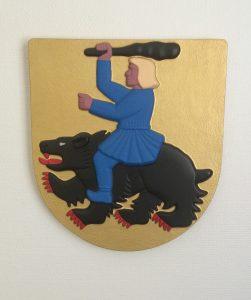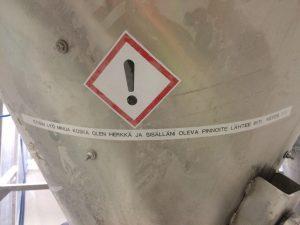
Lapua’s coat of arms. Bad-ass design, wouldn’t you say?
A well-built man is riding a bear, with his fair hair blowing in the wind. In his hand, he holds a mallet, ready to teach a lesson to those at risk of straying from the straight and narrow. As if the bear weren’t enough to keep people on their toes… No, we haven’t wandered into a fantasy story or a LARP convention; instead, we have both feet firmly on the ground in Finland’s Lapua. I am looking at the town’s official coat of arms, and, even though I may not be qualified to evaluate its artistic merits, I can tell you it’s one bad-ass design. Full marks for that, as no-one could accuse the locals who designed it of suffering from a lack of self-confidence.
‘Networking’ is the word on everyone’s lips these days. Knowing people with different backgrounds and skills is seen as valuable. Nobody can be the master of everything, and you can never tell which skills will be essential in a project slated for 2025. That’s why I can warmly recommend networking with residents of Lapua. You never know when a man riding a bear, waving a mallet, may be needed for a project. On the other hand, what project couldn’t use one of those!? Because of that, I’ve decided to offer you a unique set of networking instructions. The process consists of two stages.
- Enter Lapua into Google Maps, and locate it on a map of Finland, close to the city of Seinäjoki. This stage is essential, since it’s only good manners to have some idea of where the person you want as a contact hails from.
- Join LinkedIn and begin to follow Chemigate.

Note the correct spelling: Chemigate. Not ‘Chemigayt’, as my beloved student buddies in Aalto University’s Forest Product Guild are wont to spell it.
Chemigate isn’t able to guarantee direct contact with these mythical bear-riding locals, but what they can do is to ensure a supply of world-class starch-based biopolymers, particularly for forest-industry applications.
Starch-based biopolymers for forest-industry applications involve the use of modified potato, barley, or wheat starch in paper production. Yes, you read that correctly: potatoes, barley, or wheat in your paper. At Aalto University, in my studies in bioproduct technology, I learnt the basics of paper production, so I’m aware of the importance of starch in the process. However, it was only during my visit to Chemigate’s production facilities that I realised that the starch used in paper production is the same starch covering a quarter of my dinner plate in the form of potatoes or pasta, as recommended by dietary experts. This realisation gave me pause for thought. There really are farmers in Finland who grow potatoes for paper machines to swallow. Mind-blowing.
This is yet another example showing how important it is for students to get out of the lecture halls and see things with their own eyes. I currently study bioproduct technology at Aalto University, in Otaniemi, Espoo. It used to be called wood processing. Now it goes by the sexy name ‘chemical, biochemical, and materials engineering’. Students in the field are often called process students.
The only constant at Aalto University is change, and after all these name changes, I find it hard to be certain of what my study subject is called. It may be easier just to call myself a technology student. And Master of Science in Technology in a couple of years.

But before that, I will be Chemigate’s blogger for the next year, writing one piece per month, on average. I’d be extremely happy to receive feedback on my writings. Five summers temping as a journalist taught me that nothing is more uninspiring than receiving zero feedback on your articles. You can also propose topics for my blog. Feedback and ideas can be sent to marketing@chemigate.fi. I won’t be writing this blog for myself or even Chemigate but for my readers. Let’s make the next year brilliant!
Chemigate’s blog-writing ‘super-techie’
Paavo Vallas

